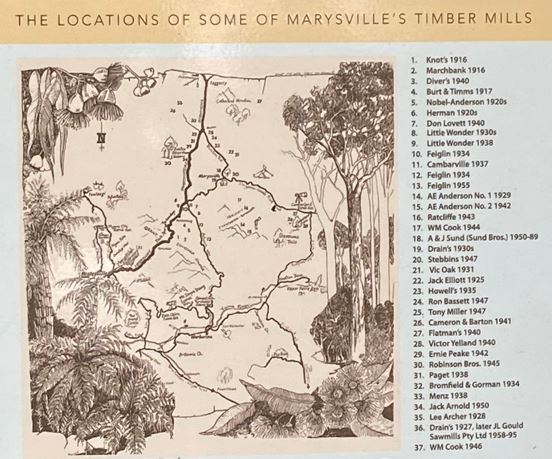Marysville Heritage Trail (The Timber Story)

.jpg)
The exhibits and information panels for the (The Timber Story are located around the outside of the Marysville Visitor Information Centre.
The logs were all cut, of course with a cross cut saw and barked by hand with an axe ... and whoever worked there would be working in mud all the time ... everything was done out in the open no matter how wet it was. - John Lloyd Gould, 1985

In around 1909 a Mr Knotts opened one of the first sawmills at Mount Dorn Dom on the Black Spur Other mills sprang up as roads improved and cut deep into the forests. Timber harvesting in the ash range was a risky and arduous task. Bullock and draught horse teams hauled logs to the mills for cutting, while tram tracks along steep inclines provided pathways for heavy logs. Timber workers suffered a high risk of injury as they hauled the logs by bogeys to the mills.
Nestled in the Great Dividing Range, the Marysville Forest is home lo the largest concentration of Mountain ash (Eucalyptus regnans) in Victoria. It was in this forest that early timber workers made their living.
Mountain ash is one of the tallest hardwood species in the world. Splitting mountain ash was the main job of the men known as paling cutters, who first came to this area in the late 1880s. By the 1930s, Mountain ash was considered one of Victoria's most important forest trees.
Many sawmills became the heart of tiny forest communities. Some mills had houses for the workers while larger mills, such as Cambarville Mill and Andersons Mill, boasted small one-teacher schools.
The disastrous bushfires of 13 January 1939 almost engulfed Marysville and did untold damage to the district's forests. Sawmill owners built new mills to salvage dead trees in the years following Black Friday. By 1956, the Marysville region was home to many sawmills, including Feiglin, Narbethong, Lovett, Radcliffe, Cook, Sund Stenco, Vic Oak, Bassett, Miller, Cambarville, Little Mill, Robinson and EJ Anderson. These mills handled 56,000 cubic metres (24,000,000 super feet) of timber per year, with an annual. turnover of approximately 1,200,000 pounds. The mills employed over 300 men and provided a livelihood for about 1,000 people.
The Black Saturday fires of 7 February 2009 destroyed two Narbethong timber mills. Narbethong Timber & Trading Co (formerly Feiglins) and Bennetts Pine Mill. Much of the surrounding forest was destroyed but the trees, like Marysville and District are slowly regenerating.
Location
11 Murchison Street, Marysville 3779 View Map









